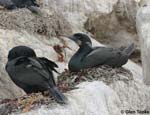Brandt’s cormorant (Phalacrocorax penicillatus) is a large seabird known from the Pacific coastline of North America. Cormorants, also known as shags, are common to coastlines around the world. Most evidence suggests that they are related to a large group of other seabirds, including penguins, loons, and grebes, and may be most closely related either to frigatebirds and tropicbirds (Mayr and Clarke, 2003) or to boobies and darters (van Tuinen et al., 2001). Seabirds are highly convergent, however, owing to their extreme adaptations to similar, aquatic environments, and their relationships are greatly in need of revision.
(Phalacrocorax penicillatus) is a large seabird known from the Pacific coastline of North America. Cormorants, also known as shags, are common to coastlines around the world. Most evidence suggests that they are related to a large group of other seabirds, including penguins, loons, and grebes, and may be most closely related either to frigatebirds and tropicbirds (Mayr and Clarke, 2003) or to boobies and darters (van Tuinen et al., 2001). Seabirds are highly convergent, however, owing to their extreme adaptations to similar, aquatic environments, and their relationships are greatly in need of revision.
Living cormorants are often grouped within one genus (Phalacrocorax) containing 36 species and a second genus (Leucocarbo) containing two (Antarctic) species (van Tets, 1976). The most recent examination of relationships within cormorants reconstructs Brandt’s cormorant as being closely related to Wahlberg’s cormorant from South Africa, the flightless cormorant of the Galapagos, the black-faced cormorant of Australia, and the extinct spectacled cormorant from Bering Island (Siegel-Causey, 1988). All these species, known as the marine cormorants, share heavy bodies, flexible wing tips, and wide distributions; they are also the strongest and deepest divers of all cormorants (Siegel-Causey, 1988).
Brandt’s cormorant is a strictly marine bird named for the 'painter’s brush' (pencillatus) of white hairs seen on its neck and back during breeding season. It is a large bird, with a wingspan over four feet, and also displays a distinctive, bright blue patch on its throat during mating season. The species ranges along the Pacific Coast from northern Canada to the southern Baja Peninsula and generally does not migrate. Like all cormorants, Brandt’s is a foot-propelled diving bird that pursues small fish, often diving over 150 feet to the sea floor. This hunting often occurs in large, communal flocks, as does nesting and breeding. Brandt’s cormorant is not endangered, with a large and widespread population of over 230,000 birds.
Additional Information on the Skull
Click on the thumbnails below for labeled images of the skull in standard anatomical views.


Literature
Mayr, G., and J. Clarke. 2003. The deep divergences of neornithine birds: a phylogenetic analysis of morphological characters. Cladistics 19:527-553.
Siegel-Causey, D. 1988. Phylogeny of the Phalacrocoracidae. The Condor 90:885-905.
van Tets, G.F. 1976. Australasia and the origin of shags and cormorants, Phalacrocoracidae. Pp. 121-24 in: Proceedings of the 16th International Ornithological Congress, Canberra, Australia, 1974.
van Tuinen, M., D.B. Butvill, J.A.W. Kirsch, and S.B. Hedges. 2001. Convergence and
divergence in the evolution of aquatic birds. Proceedings of the Royal Society of London B: 268:1345-1350.
Links
Phalacrocorax penicillatus page on Wikipedia
P. penicillatus at birdweb.org
P. penicillatus at birdnature.com


